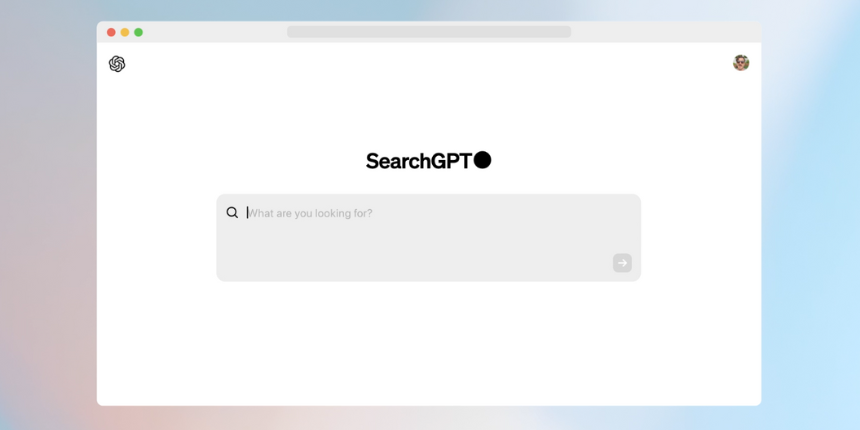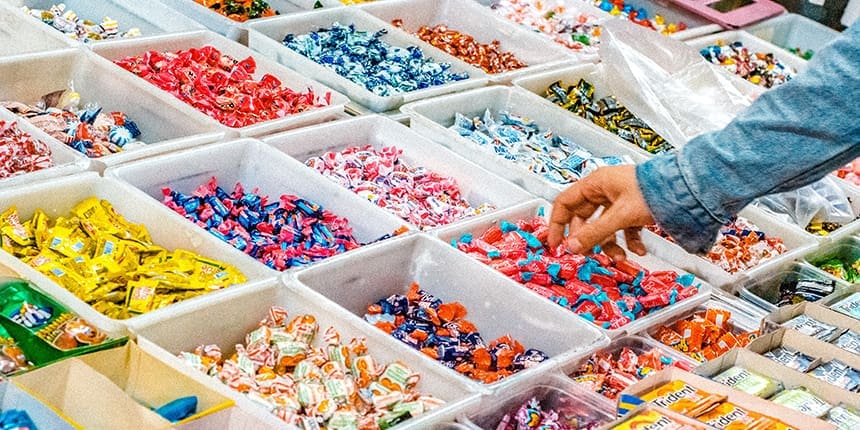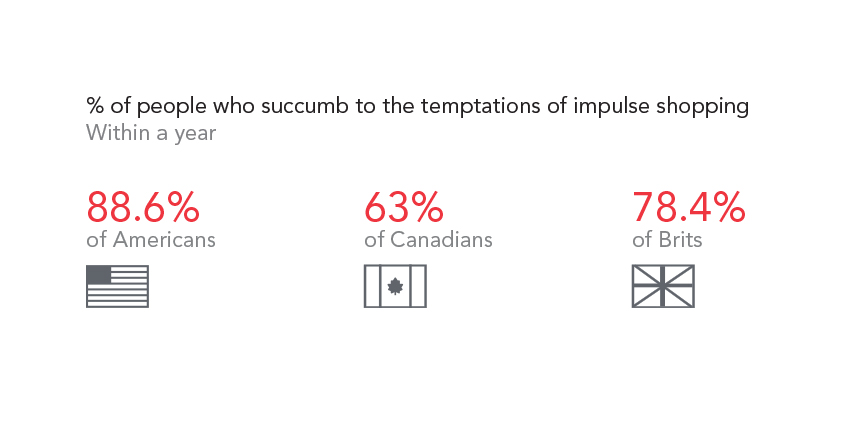
Navigate an unpredictable landscape with actionable, data-driven strategies tailored for your business from the brand down to the local level.

Retail therapy can be defined as the act of shopping with the sole purpose of improving one’s mood or disposition. We’ve all been there—buying things on impulse to relieve stress after a bad day or to treat yourself after a long week. For an example, look no further than your own shopping habits. Take a look at the receipt from your last shopping trip (or your latest online purchases) and consider why you added each item to your cart in the first place. What was driving your purchase decision? Chances are, there is at least one item in there that you wanted more than you needed.
According to statistics, consumers in North America and the UK tend to follow similar patterns when it comes to their impulse shopping habits.
88.6% of Americans have succumbed to the temptations of impulse shopping, with an average spend of $81.75 per session or $17.78 billion per year. Americans also make up to 156 impulse purchases every year, spending up to $5400 annually, or $324,000 over their lifetime. On a smaller scale, impulse shopping is also prevalent in Canada—63% of Canadians admitted to shopping impulsively, with an average spend of $73.81 (CAD) or $8.8 billion per year.
These impulse shopping trips aren’t isolated events, nor are they a rare occurrence. The New York Post references a poll conducted on Swap.com showing that Americans spend up to 65 hours per year shopping online and 90 hours per year shopping in-store. Of this, over a fifth of all retail purchases (22%) were bought in the name of retail therapy. Invesp also found that 40% of the money spent on e-commerce websites were impulse purchases.
In the UK, Mortar London on behalf of Finder.com found that 78.4% of Brits succumbed to impulse shopping and more than 22.9% were making impulse purchases on a weekly basis. A study by MYJAR for the Independent estimates that impulse buys account for about 108 purchases a month, equating to an average of £200 a month, or £143,902 over a lifetime. Of these respondents, 4 in 10 admitted to making purchases in the name of retail therapy and 54% of these purchases were happening online.
Clearly, this means retailers should never underestimate the power of the impulse shopper.

Remember the “Four P’s of Marketing”? These principles can help boost impulse purchases as well. Utilized in conjunction, these ideas capitalize on the compulsion to just add “one more item” without putting much thought into it.
In North America, Slickdeals found that the top five leading product categories for impulse shopping online include groceries, clothing, household items, takeout food, and shoes. This is further corroborated by CreditKarma’s research on stress spending where most of the respondents reported purchasing clothes, food, alcohol, electronics, jewelry, tattoos, and even cars to alleviate stress. As for the UK, Whistl found that the top five leading product categories for impulse shopping were clothes, food and drink, home accessories, shoes, and jewelry.
One thing to remember is an impulse purchase should be effortless and require little thought. The best impulse buy products are:
Subscribe to our monthly newsletter.
Think about the layout of any retail store or e-commerce website that you frequent. Are there any similarities that you can point out? Like how the checkout area is set up to tempt you as you’re waiting in line, or how you can never say no to those free samples around the corner? Maybe you’re shopping online and recommended items just magically appear with an emphasis on sale and clearance options.
All of this is not a coincidence. Product placement is just as important as the items that you are shopping for. Thus, retail floors and e-commerce sites are strategically designed to draw attention to products with the intention to sell and upsell. An example of a retailer that has mastered the art of drawing in impulse shoppers is Sephora.
Sephora’s retail locations have always been a sanctuary for makeup lovers and beauty enthusiasts, with the design of the store floor naturally directing customers to flow towards their POS. The Sephora POS is a formidable force notorious for encouraging last-minute, impulse purchases. Some strategies to note include:
What Sephora does well with their physical locations is what Amazon does well with their online presence, prices, and promotions. For customers, promotions create a sense of urgency, triggering the feeling of FOMO (fear of missing out). FOMO has proven to be a key factor influencing impulse purchases, with Finder.com reporting that over 50% of shoppers have blamed FOMO for their impulse buys. FOMO is truly Amazon’s bread and butter. Instead of the usual connotation of shame and guilt associated with shopping on impulse, Amazon has effectively normalized impulsivity in the purchase process. Some of the strategies they have successfully leveraged include:
Retail therapy has become a hot topic in recent years with a growing number of studies finding that it can be an effective coping and reward mechanism that can improve one’s mood. According to Dr. Kit Yarrow of Time Magazine, people are more likely to engage in retail therapy to ease life transitions such as marriage or a new job, to express one’s creativity and aesthetics, for relaxation and escape from everyday life, and as a means for social connection. These factors also seem to resonate with both consumers and businesses alike.
We are seeing a shift as retailers work on changing everything from their business model to their store layouts to accelerate the user journey and promote faster conversions. Perhaps this is a testament to our world today, defined by short attention spans, instant gratification, and a constant desire for self-expression.
But make no mistake, the “shoppers high” is real and so is its economic impact.
Want to know to keep pace with changing market dynamics and consumer behavior? We would love to chat! Get in touch with DAC!
Navigate an unpredictable landscape with actionable, data-driven strategies tailored for your business from the brand down to the local level.
Navigate an unpredictable landscape with actionable, data-driven strategies tailored for your business from the brand down to the local level.
Navigate an unpredictable landscape with actionable, data-driven strategies tailored for your business from the brand down to the local level.
Subscribe to our monthly newsletter.